
Technologies evolve, and the way businesses take advantage of them evolves as well. Just several decades ago, large corporations outsourced relatively simple IT services to developing countries with one and only purpose – to cut their costs. In 2023, the benefits you will get from IT outsourcing, namely a dedicated development team model, are much more varied. Keep on reading to check them out for yourself.
Content:
- But first, what is the dedicated team model?
- Dedicated team structure in a software development project
- Advantages of a dedicated team
- Disadvantages of a dedicated team
- Why and when to outsource your software development project?
- Dedicated teams with MWDN: How can we help you?
But first, what is the dedicated team model?
According to the Global outsourcing survey by Deloitte, 53% of businesses outsource IT functions, with a significant portion adopting the dedicated team model. The demand for this model has steadily increased, growing at a CAGR of 4.7% from 2016 to 2021.
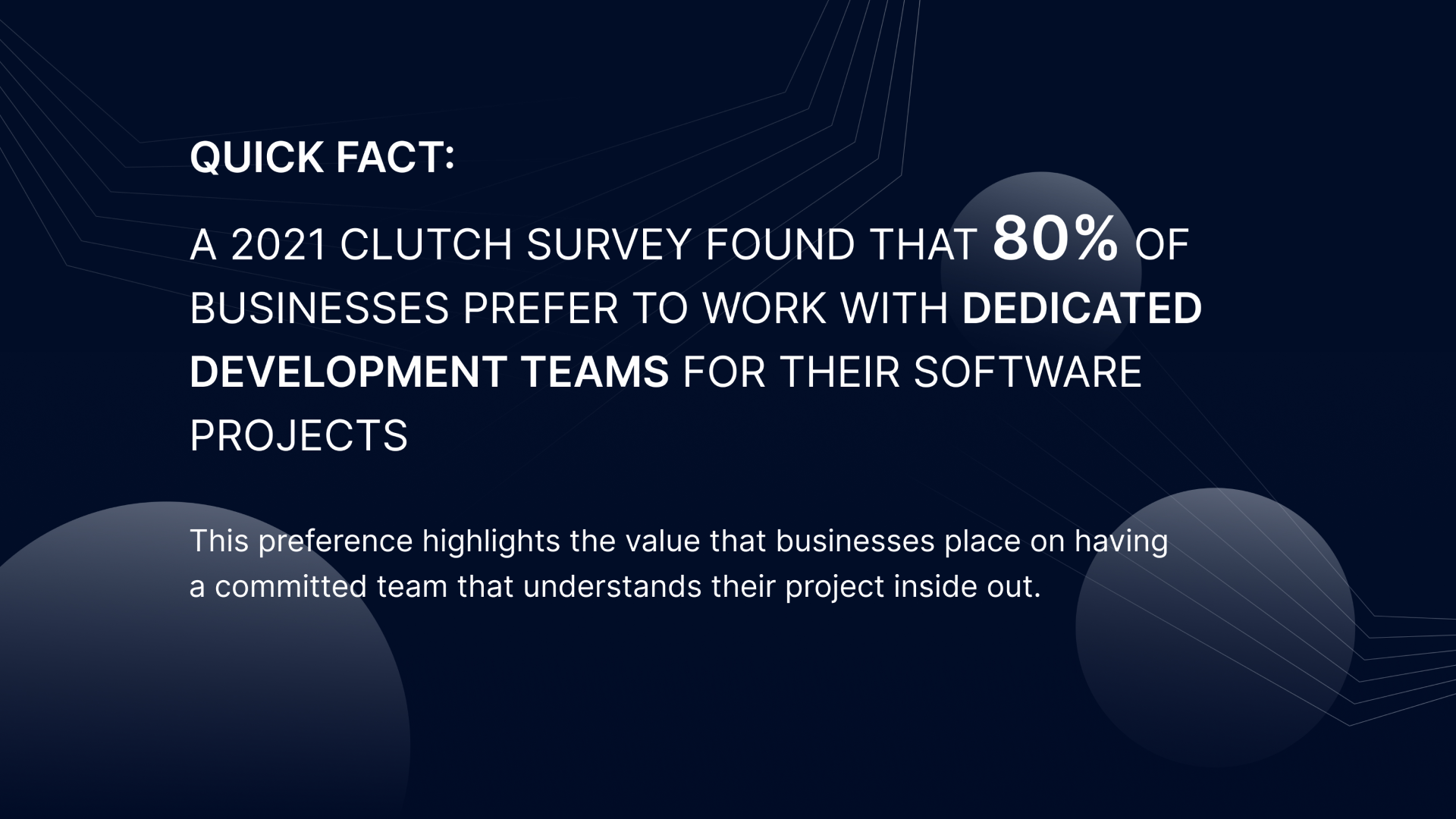
The dedicated team model is a type of outsourcing where a customer hires a team of tech specialists from a service provider to work on their projects full-time. Such a team becomes a remote “extension” of the customer’s in-house IT department, reinforcing their capabilities and aligning with their culture, processes, and objectives.
As a rule, a service provider is a recruiting agency or an outstaffing company that does the hiring, onboarding, and management and deals with administrative issues like taxes, labor law compliance, social benefits, and other organizational questions.
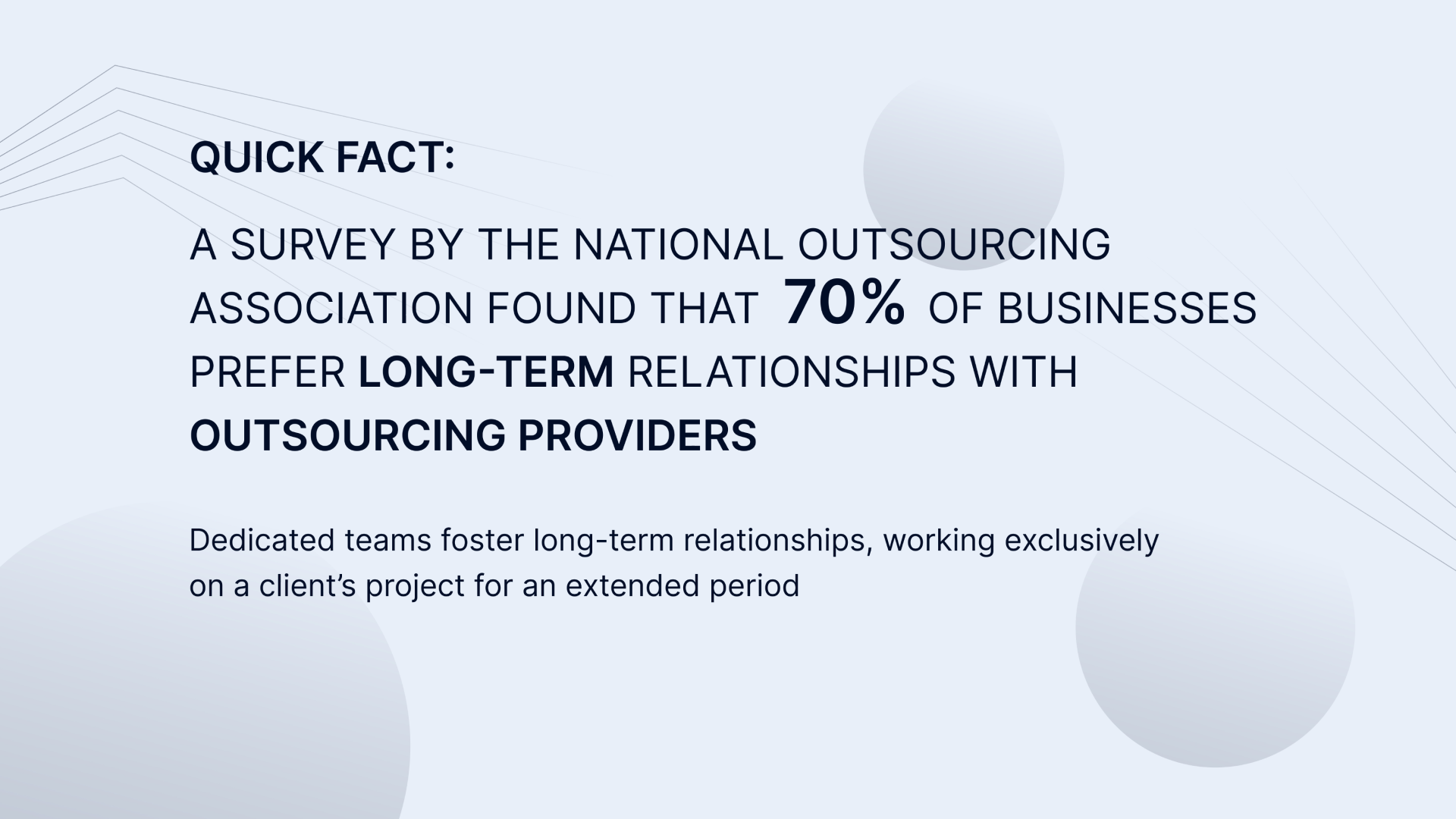
Dedicated team structure in a software development project
The dedicated project team structure is a configuration where a remote team of specialists is assigned exclusively to a particular project for its duration. This setup ensures that the team is wholly focused on the project’s goals, leading to enhanced efficiency and productivity. Below are the key roles within a dedicated team structure.

Product owner – strategic planning and business issues
A product owner can be a part of your in-house team or a C-level manager hired to become a link between your business and the outsourced project. It is someone guiding the product vision and prioritizing work based on value.
The PO role is often intertwined and mixed up with the role of the project manager. According to some business practices, a Product owner is responsible for defining and prioritizing the product backlog, ensuring that the team works on tasks that deliver the highest value to the business. According to other beliefs, these are tactic-level tasks that a project manager should perform.
Project manager – tactic decisions and team boosting
Project managers play a pivotal role in maintaining the structure and discipline of a software development project, ensuring that all aspects of the project are moving forward as planned. They need to have a good understanding of software development processes, as well as strong leadership and management skills.
PM’s key responsibilities include:
- project planning (scope, goals, deliveries),
- creating a detailed road map for the project,
- determining the resources required to complete the project,
- team management (assigning tasks, setting deadlines, ensuring that the team has the necessary resources),
- timeline management,
- reporting and documentation.
An efficient PM with good leadership qualities, a problem-solving attitude, and organizational skills is half of your success with a remote development team. So, be sure to put on paper all your high expectations for the PM role to your recruitment partner.
Business analysts – amending technology capabilities to business needs
The Business analyst is yet another liaison between business stakeholders and the technical team. The BA ensures that business requirements are properly understood, documented, and translated into technical specifications. The main goal of a Business analyst is to improve the efficiency of business operations through the use of software solutions.
The BA will gather and analyze business needs and stakeholders’ requirements to create detailed business documents to guide the software development process. They help to bridge the gap between business and IT, ensuring that the technical solutions delivered meet the business needs.
Designers – interface usability
User interface (UI) and User experience (UX) designers focus on the design and usability of a product. They work to ensure that the software is not only functional but also easy to use, visually appealing, and provides a positive experience for the users. They contribute to increased user satisfaction, which can lead to higher user adoption rates and ultimately contribute to the success of the software product.
Software developers – the working bees of every project
Almost half of the money you pay for app creation will be paid to software developers. Front-end and Back-end developers are the basics of your project. In a nutshell, they write code and make things work.
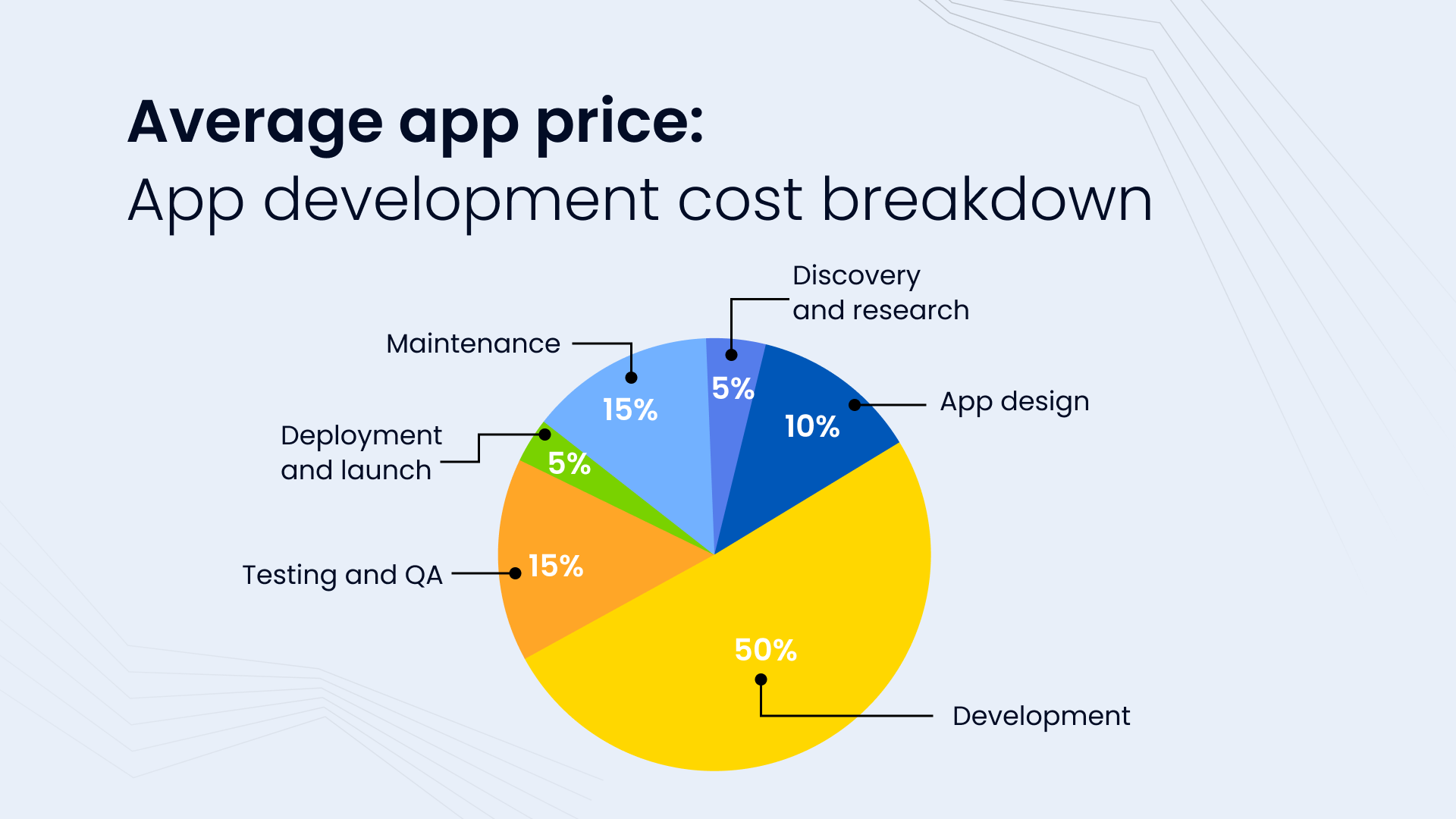
Quality assurance – software testing and quality control
Theoretically, your project can do without a QA/QC specialist, but it would feel so much better with one. Usability, security, and performance – they all have to be tested before your project sees the world, while all the bugs should be noticed and eliminated. This is what a QA team is for – to make your project better.
DevOps and SysAdmins – making everything run smoothly
DevOps engineers work to automate and streamline operations and processes to improve the speed, efficiency, and quality of software development, testing, and deployment.
A System administrator, on the other hand, is responsible for managing, maintaining, and ensuring the optimal performance of a company’s computer systems, servers, and networks. Their role is critical to ensure that the IT infrastructure of an organization runs smoothly, securely, and efficiently.
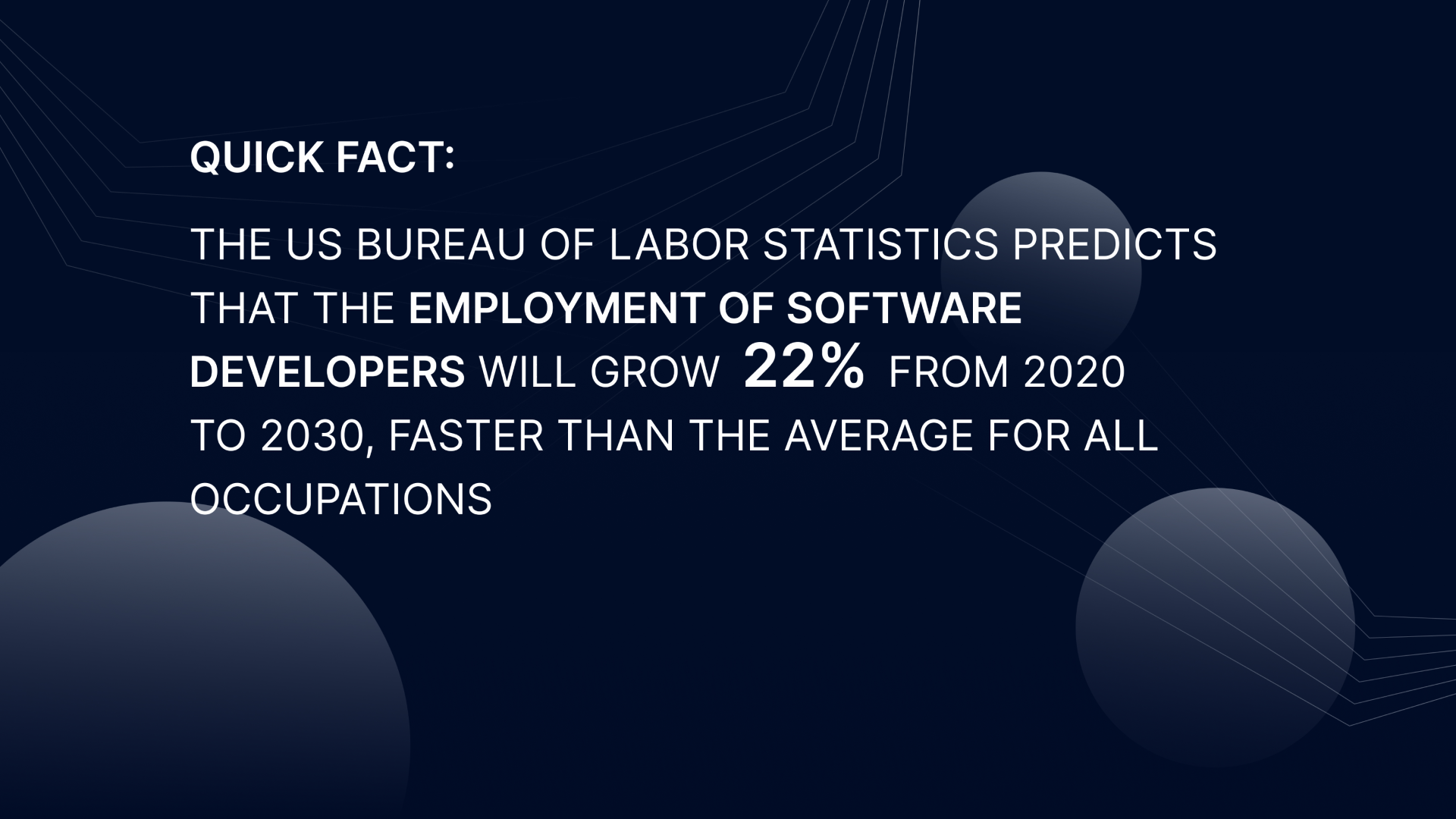
Hopefully, now you have a better understanding of what is a dedicated project team structure.
Advantages of a dedicated team
According to Deloitte survey 2023, the main reason to outsource IT services or hire a dedicated team is still to cut direct labor costs. Another big purpose of the model is to reinforce an in-house team with some particular tech talent that is hard to find locally. What are the other pros of dedicated teams? Here is our top five.
- Focused expertise. The team is selected based on the specific needs of the project, ensuring that the necessary skills and knowledge are present. Moreover, team members are solely dedicated to your project, ensuring maximum attention and effort. This results in higher productivity, quicker problem-solving, and more efficient workflow.
- Enhanced collaboration. The team works together exclusively on one project, fostering better communication and collaboration. Working together exclusively fosters a strong sense of teamwork and camaraderie. This leads to a more positive working environment, enhancing productivity and job satisfaction.
- Flexibility. The team can quickly adapt to changes in the project scope or objectives, ensuring agility in the development process. It’s easier to scale the team up or down based on the project’s requirements. The project can adapt more readily to changing needs, ensuring optimal resource utilization.
- Consistency as the result of long-term relationships. The same team working throughout the project ensures a consistent approach and quality. The final product is cohesive, and the likelihood of errors or inconsistencies is reduced. Over time, the team gains a deep understanding of your business, leading to better-tailored and more effective solutions.
- Faster project delivery. The undivided attention of the team means that milestones can be reached more quickly. The project will likely be completed on schedule, providing a competitive advantage.
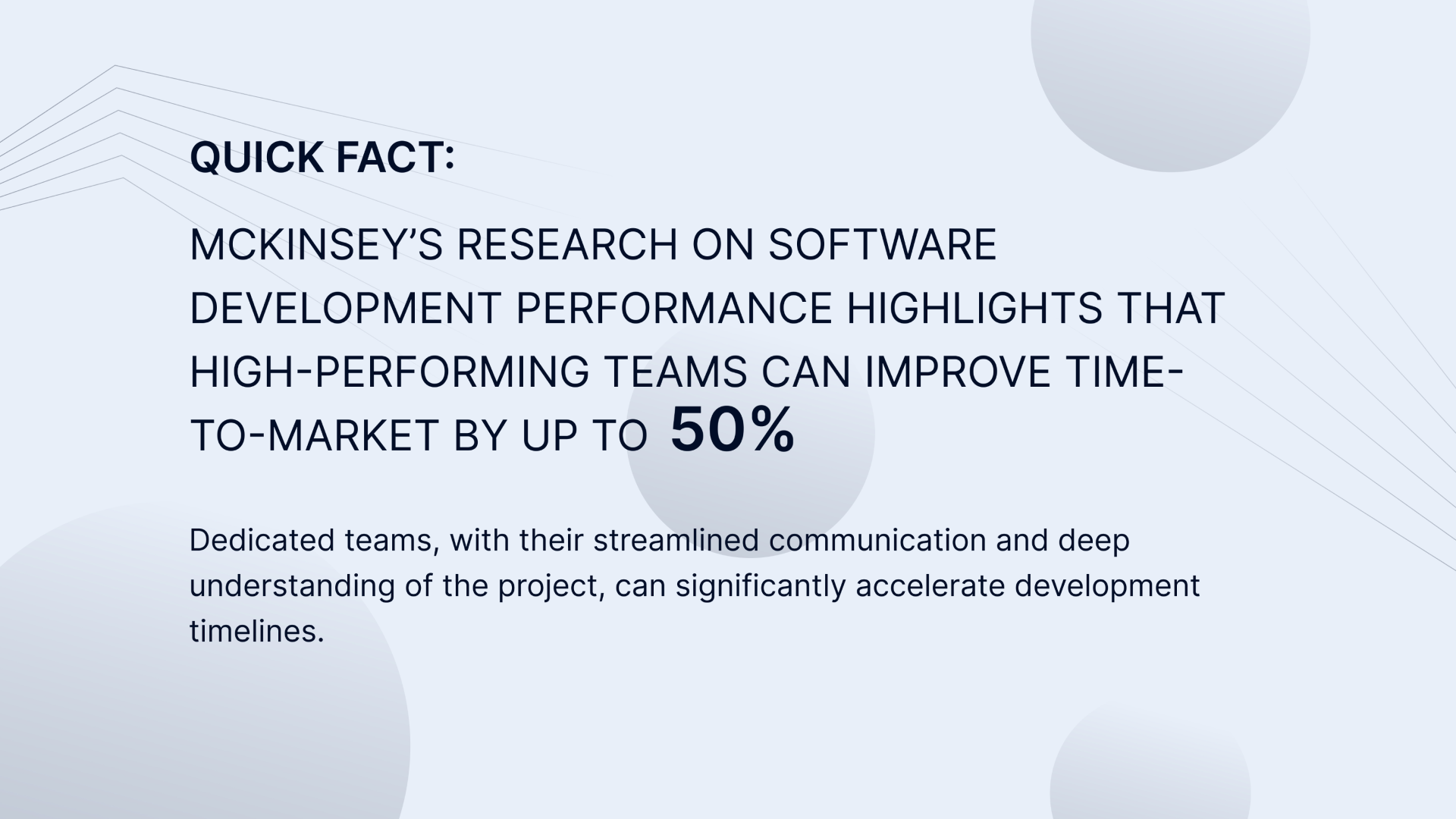
For some cases, though, a dedicated team model is not the best choice. Check out the key disadvantages of a DTM below to make an informed decision about adopting this model for your project.
Disadvantages of dedicated teams
- DTM is not for short-term projects. A dedicated team requires a long-term commitment, which might be challenging if the project’s future is uncertain. You might be locked into a commitment that becomes unsuitable as the project or market conditions evolve. What’s more, reducing the team size, when necessary, can be complicated due to contractual obligations and the potential impact on team morale, so the project might carry unnecessary costs if scaling down is delayed or avoided.
- Communication challenges are possible. DTM is much better than traditional outsourcing regarding team control and quality of communication, but it’s not the same as you would have with an in-house team. Misalignments and misunderstandings could potentially derail the project.
- Relatively limited flexibility. DTM is surely more flexible when compared to traditional in-house hiring; however, it is less flexible than outstaffing. Once your dedicated team is established, making changes or bringing in new skills can be challenging. The project might suffer if new expertise is required mid-way through.
- Potential for high costs. The costs of maintaining a dedicated team can be high, particularly if the project duration extends. Initial costs might be higher than you expect as well, as your project might require a significant initial investment to gather the necessary talent and resources.
- Indirect team management. You might feel uncomfortable having an additional management level for your remote team. Even though having a dedicated project manager or a product owner can be beneficial, the final choice of the dedicated team structure should be yours.
- Possible time-zone differences or language barriers. If your dedicated team is situated in another country and speaks another language than your in-house team, issues may arise. You can always solve them “on the shore” by communicating them directly in the agreement.
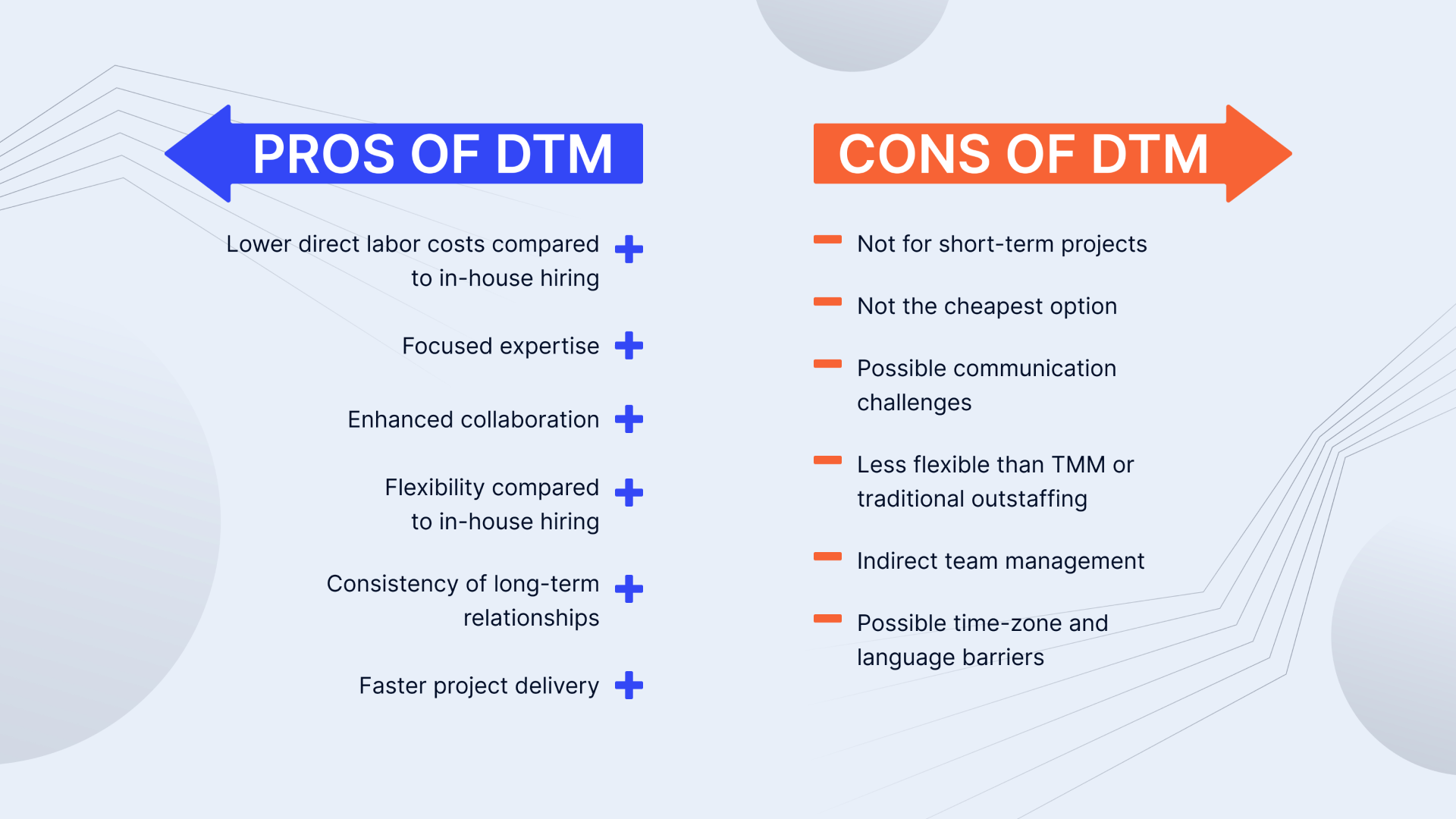
Why and when to outsource your software development project?
A dedicated team model is not a bliss that will suit every particular project. As good as it is, it can be simply not your best choice. Here is a list of cases when you should consider hiring an outstaffing company that will find you the best dedicated team.

Reasons why you need a dedicated development team
👾 1st scenario – Specialization. Your company wants to develop a mobile application, but your in-house team specializes in web development. Imagine you’re a retail company looking to create an augmented-reality shopping app. By hiring a dedicated team that specializes in AR and mobile app development, you will get access to the necessary skills and experience, which will lead to a higher-quality product.
💰 2nd scenario – Money. You’re a startup looking to develop a CRM system, but developing the software in-house would require hiring new employees or training existing ones, which could be costly. Try hiring an offshore dedicated team in a country with lower labor costs. This approach will significantly reduce development costs and help you achieve the desired outcome.
🚀 3rd scenario – Speed. You’re a finance company looking to launch a new online banking feature quickly. Outsourcing or hiring a dedicated team can provide access to a ready-to-go team, reducing the time spent on recruitment and training.
🧑💻 4th scenario – Uncertainty. You have just created an image of your future project, but the road map is still void. You need help, but you can’t choose traditional outsourcing as you don’t know how much time and effort your project might take. Hiring a dedicated team is the best choice as this approach combines the best from in-house teams and outsourcing.
🧑🎓 5th scenario – Talent gap. Imagine that the specific skills required for your project are rare or expensive in your local job market. Outsourcing globally can provide access to a broader talent pool, often at a more affordable rate.
💻 6th scenario – Software is not your strong point. If software development is not a core competency of your business, and managing a development project could divert resources from critical operations, hiring a dedicated team can become a way out. Outsourcing will allow you to maintain focus on what you do best while still achieving your software development goals.
What’s the difference between the dedicated team model and the time and material approach?
As we provided the dedicated team meaning above, let’s focus on the time-and-material approach. The time and material model is more flexible, charging the client for the time spent on the project and the materials (or resources) used. The client is billed periodically (e.g., hourly, daily, or weekly) for the work completed. Your time-and-material team may be working on multiple projects simultaneously. The TMM works well for projects with uncertain scopes, where flexibility is key, and the client prefers to pay for exactly what is used and completed.
What’s the difference between the dedicated team model and traditional outsourcing?
Traditional outsourcing involves hiring external vendors for specific tasks or projects, possibly leading to less cohesion but potentially offering more specialized skills for short-term needs. With traditional outsourcing, you cannot control the working process, you don’t communicate with an outsourcing team, and the payment policies are not particularly transparent.
What’s the difference between the dedicated team model and staff augmentation?
Staff augmentation involves supplementing the client’s in-house team with external professionals. This approach provides specialized skills as needed, maintaining internal control while adding necessary expertise. We believe that this is one of the best approaches to delegating software development.
Dedicated teams with MWDN: How can we help you?
With over 20 years in the software development market, we understand that the dedicated team model is one of the best approaches to IT services delegation. DTM is the perfect combination of control and communication that you have with your in-house team, lower costs, and a wider talent pool than you can expect from traditional outsourcing.
We provide dedicated team services to small, medium, and large companies working in FinTech, HealthCare, Logistics, NextGen technologies, and Manufacturing. Whatever your needs and resources are – we can offer you something you will certainly like. Contact us to calculate the price of your dedicated team and find out more about our capabilities.
Content
- 1 But first, what is the dedicated team model?
- 2 Dedicated team structure in a software development project
- 2.1 Product owner – strategic planning and business issues
- 2.2 Project manager – tactic decisions and team boosting
- 2.3 Business analysts – amending technology capabilities to business needs
- 2.4 Designers – interface usability
- 2.5 Software developers – the working bees of every project
- 2.6 Quality assurance – software testing and quality control
- 2.7 DevOps and SysAdmins – making everything run smoothly
- 3 Advantages of a dedicated team
- 4 Disadvantages of dedicated teams
- 5 Why and when to outsource your software development project?
- 5.1 Reasons why you need a dedicated development team
- 5.2 What’s the difference between the dedicated team model and the time and material approach?
- 5.3 What’s the difference between the dedicated team model and traditional outsourcing?
- 5.4 What’s the difference between the dedicated team model and staff augmentation?
- 6 Dedicated teams with MWDN: How can we help you?